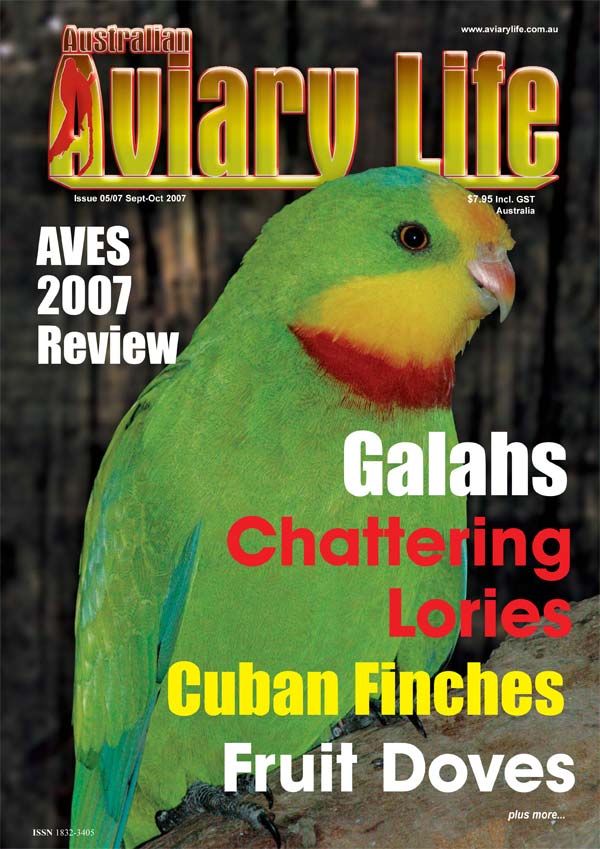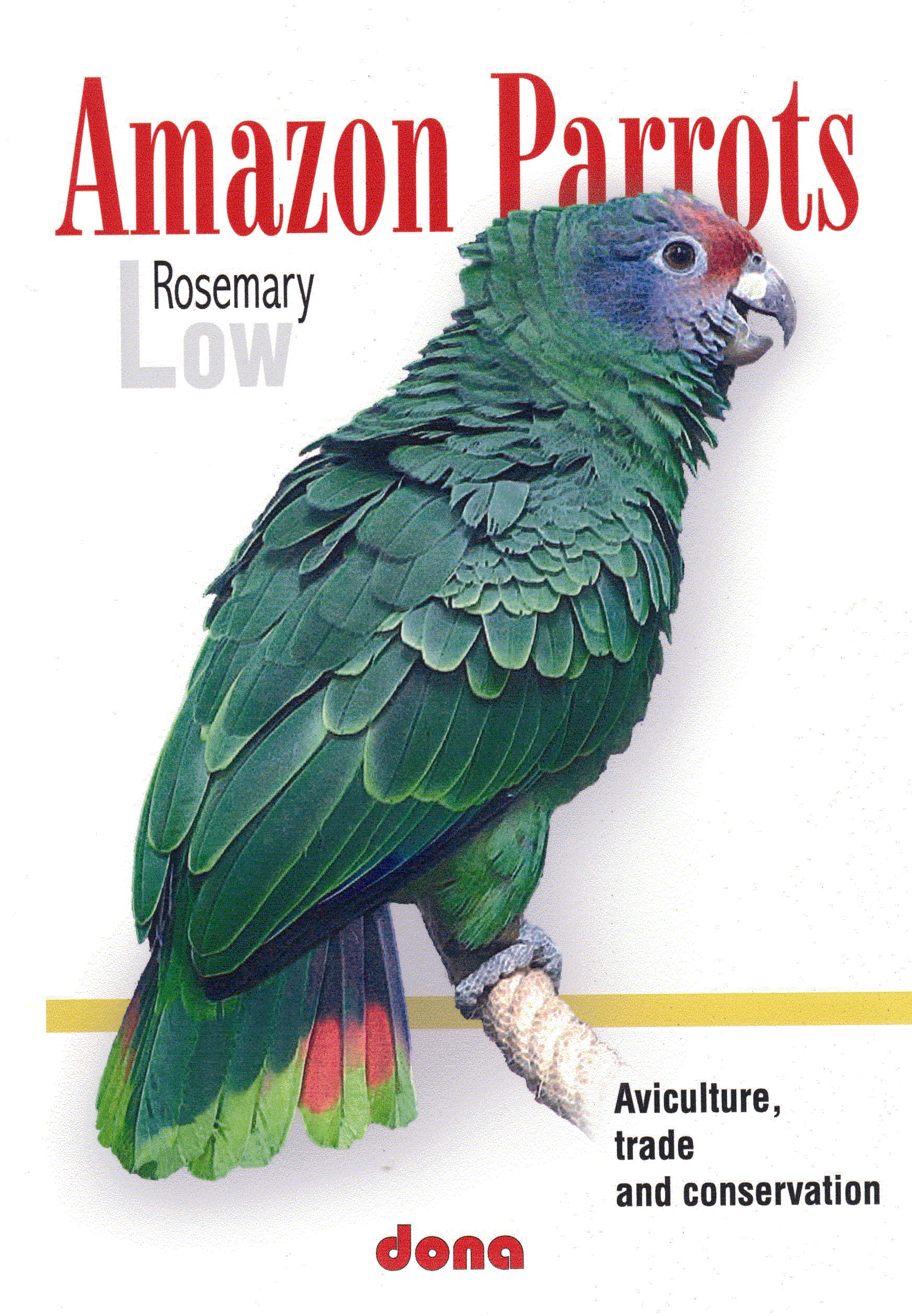Double Yellow-headed Amazon
The Double Yellow-headed Amazon is without doubt one of the most beautiful and prized species of Amazon available to aviculturalists world wide. Their popularity and desirability within Australia is driven by a number of factors some of which include their rarity, beautifully adorned plumage, great pet qualities and talking ability. A bird with huge potential, the Double Yellow-headed Amazon is rarely written about in Australian aviculture. The following article is aimed at shedding some light on these beautiful birds.
Description
A medium sized parrot, the mature Double Yellow-headed Amazon (Amazona oratrix) measures approximately 35 to 37 cm’s in length and is predominately green in colour. As the name suggests the head is yellow with the yellow extending down to the throat. The bend of the wing is yellow and red and the speculum red and legs light grey. The beak is horn and the iris orange red in colouration. Immature birds have a smaller yellow patch on the forehead and brown iris. The beak of young birds is grey in parts.
The yellow increases with age with some birds having completely yellow heads after just a few years of age however the majority take quite some time with each moult bringing about an increase in the yellow on the head.
Sub-species
Once thought to be a sub-species of the Yellow-crowned Amazon (Amazona ochrocephala) great debate between taxonomists continues with some believing the Double Yellow-headed is in fact a separate species. For the purpose of this article the Double Yellow-headed Amazon is treated as the nominate race of a separate species with three other sub-species occurring within the group. Those sub-species are A. o. tresmariae, A. o. belizensis and A. o. hondurensis.
Housing
The Double Yellow-headed Amazon is one species that is perfectly suited to being housed in a suspended aviary. As mentioned in previous articles relating to the Yellow-crowned Amazon the suspended aviary has many advantages over the conventional type aviary and is perfectly suited to housing many of the Amazon Parrots. One advantage for housing these birds in suspended aviaries that can not be overlooked relates to the behavior of these birds during breeding season. Double Yellow-headed Amazons in breeding mode are fiercely territorial and will attack anyone entering their aviary.
In a conventional aviary an aviculturalist is more likely going to have to enter the aviary to clean it during the breeding season thus causing the bird’s undue stress and themselves possible harm. Where as suspended aviaries do not require as much cleaning due to the fact that most fouled foods and faeces fall through the aviary floor. Thus limiting the time the aviculturalist is actually interacting with the birds thus limiting the stress caused and possible harm to the keeper.
A suspended aviary made out of steel measuring a length of 4 metres long x 1.2 metres wide x 1.2 metres high backing onto a safety porch is suitable for housing this species in. 50% of the roof may be constructed of wire at the front to allow these birds to bathe in the rain and to enjoy the sun light. A strong quality gauged wire such as 1.3mm gauge x 12.5 mm x 12.5 mm should be used. Anything to weak and the birds may break the wire and enjoy a free flight. When housing these side by side a solid partition should be used. Similarly it has been found that when housed beside birds of another species a solid partition or double wiring should be used. This will prevent cocks and hens from focusing on fighting with their neighbors rather than mating.
Feeding
A good varied diet consisting of seed and or pellets, in season fruits and vegetables, fresh water, nuts and soaked or sprouted seed should prove to be a sufficient diet to maintain these birds on.
The list of suitable fruits and vegetables that can be fed is almost endless. Whole or halved grapes are relished, beetroot, passion fruit, pumpkin, sweet potato, starfruit, apple, pomegranates and celery are just some of the fruits and vegetables, regularly available, which may be fed to these birds. A variety of nuts may also be fed to Amazons with pecans and almonds the more readily available. Nuts however must be fed sparingly as many species of Amazon including the Double Yellow-headed are prone to obesity. A novel way to sparingly feed nuts to these intelligent birds is to remove the kernel an place it within another “safe object” such as a piece of wood or a safe toy, This will allow the bird to still have access to this tasty morsel but also provide mental stimulation at the same time. Likewise to keep the birds from getting bored the mix of foods fed can be changed weekly or daily if need be. A good varied diet will aid to keep the birds plumage vibrant, provide mental stimulus and keep the birds healthy.
Breeding birds are fed a slight increase in nuts and fruits and veg in the lead up to the breeding season. Fruits and vegetables are fed twice a day to pairs with young in the nest. Some breeders also ad calcium supplement to the diet in the lead up to and during the breeding season. Other breeders I have spoken to do not do a great deal.
Breeding
Sexually maturity is reached at around two to three years of age however eggs should not be expected until the third year. Clutch sizes vary from two to three and sometimes four eggs with incubation lasting from 26 to 29 days. Handrearing of young is quite common amongst Australian aviculturalists and for a number of reasons.
A large vertical, boot or Z style nestbox is a suitable nesting receptacle for breeding these birds. The boot and Z style nestboxs have an added advantage in that if a hen or cock dives in the box the eggs are less likely to be broken. Likewise a vertical style nestbox placed on a slight angle can have a similar effect. The nestbox should be made of a sturdy material and be fitted with a wooden ladder, chew block for the sitting hen and contain nesting material such as wood shavings or as some prefer a mixture of peat and sawdust.
The aggressive nature of a breeding pair of Double Yellow-headed Amazons should never be underestimated. Double Yellow-headed cocks and hens like many of the Amazon Parrots are famed for giving off dramatic threatening displays. It does seem though that when compared to the other species of Amazon kept within Australia the Double Yellow-headed Amazon is more excitable and more likely to attack their keeper. They may fly at anyone entering their aviary or make lunges in an attempt to scare off or bite anyone or anything they perceive as a threat. Attacks such as this can be prevented by watching the bird/s body language. Double Yellow-headed Amazons usually fluff up, dilate their pupils, out stretch their wings, make an array of vocalisations or fan their tail before attacking. If stressed these birds may also attack their own partner in what is termed misplaced aggression. This should always be watched out for and if the birds are getting overly aggressive a good idea would be to leave the birds in peace.
Once the breeding season has finished these birds usually return to their old inquisitive and amusing self. It is during this period of time that one gets to truly appreciate the beauty of these birds. Their inquisitive nature and love of chatting to themselves and others in the aviary complex could captivate anyone for hours on end.
Pet Qualities and Talking Ability
The Double Yellow-headed Amazon is a popular choice of pet through out the world although on the expensive side in some countries. As pets they are endearing and strong willed with an ability to form a strong bond with their owner. As talkers they have an ability to enchant humans with their ability to recite poems, nursery rhymes, songs and words although not all birds build up a big vocabulary. This ability to captivate people by singing and reciting nursery rhymes can now be seen on internet websites such as Utube where proud owners display videos of their pet birds.
Housing Pets
Pet Amazon Parrots require a large sturdy cage with suitable bar spacing and plenty of toys to play with. Foraging toys in particular are great for these birds as are the branches of Bottle Brush, Grevillia, Eucalypt species and Golden Cane Palms. The cage should be positioned in a safe spot away from draughts and potentially stressful or dangerous situations. Again a plentiful supply of sturdy toys are a must particularly if the owner is absent for most of the day. Rope toys are currently riding a wave of popularity but must be watched for signs of fraying so as to prevent birds from getting their toes, legs or even head stuck.
Rare Jewels
Although increasing in numbers each year, the increase is relatively small compared to some of the other exotic species currently available in Australia, There is currently an imbalance of numbers between the sexes with males outnumbering the available hens and this is reflective in the higher price tag that pairs if this species still command. An unfortunate occurrence in the avicultural hobby is the prevalence of some people who always want to talk the price of a species down, this is almost always because they don’t keep these birds and in a hope that they can get their hands on a pair of these birds quicker. Despite the attempts by a few to bring the price of these birds down the Double Yellow-headed Amazon will remain at a price that unfortunately means they will remain outside of many peoples reach for some time.
Conclusion
Amongst the most intelligent of birds the Double Yellow-headed Amazon is a bird worthy of a place in the aviaries of anyone with the facilities and time to keep this bird. Whilst still heavily priced anyone who wishes to keep these birds should be willing to pay the money considering the pains at which some come to breed these birds.
Books on Amazons
Looking for a good book on Amazons? Why not visit our Rec Reading page to read up on Rosemary Low's fantastic book AMAZONS which is available from ABK Publications.  Double the Trouble
Double the Trouble
By Jade Welch featured in the Sept-Oct 2007 edition of Australian Aviarylife Amazon Parrots
Amazon Parrots
By Rosemary Low published by Dona Publications
NB:This article first appeared in the Sept-Oct 2007 edition of Australian Aviary Life Magazine. Copyright remains with the author Mr Jade Welch.
